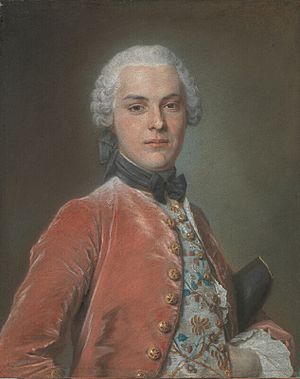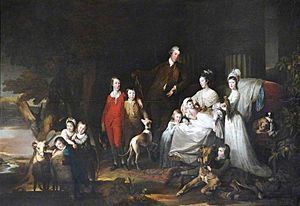Henry Dawkins facts for kids
Quick facts for kids
Henry Dawkins
|
|
|---|---|

|
|
| Born | 24 May 1728 Clarendon, Jamaica
|
| Died | 19 June 1814 London
|
Henry Dawkins II (born May 24, 1728, died June 19, 1814) was a wealthy plantation owner from Jamaica. He also served as a Member of Parliament (MP) in Great Britain. This meant he was a representative in the British government.
Contents
Early Life and Family Wealth
The Dawkins family moved to Jamaica shortly after the British took control in 1655. William Dawkins, who died in 1694, gained many plantations in Jamaica. These properties were passed down through the family.
Henry Dawkins II inherited land and wealth from his relatives. His annual income from these properties was very large, between £40,000 and £50,000. In 1775, the plantations in Jamaica made over £44,000.
When his father, Henry Dawkins I, died in 1744, he owned many plantations in Jamaica. These included Old Plantation, Parnassus, and Friendship. He also owned 1,315 enslaved people.
Life and Education
Henry Dawkins II was born on May 24, 1728, in Clarendon, Jamaica. He was the third son of Henry Dawkins I and Elizabeth Pennant. His father was a sugar planter and owned enslaved people.
Henry studied at Abingdon School from about 1739 to 1744. He then went to St Mary Hall, Oxford in 1745.
When his father died, he left a lot of land and money to his three sons. Henry received 5,700 acres of land. By 1750, he owned 20,000 acres in Jamaica. He also owned estates in Wiltshire and Oxfordshire in England. By 1809, he owned 1,464 enslaved people on his plantations.
Political Career
From 1752 to 1758, Henry Dawkins was a member of the assembly in Jamaica. He then joined the council until 1759.
In 1760, he became a Member of Parliament (MP) in Great Britain. He represented the area of Southampton until 1768. He then represented Chippenham and Hindon. He left Parliament in 1784. He served for 24 years with only short breaks.
Henry Dawkins was a member of the Society of West India Planters and Merchants. This group worked to protect the interests of plantation owners. His son, James, later took over his seat in Parliament for Chippenham.
Henry Dawkins died on June 19, 1814, in London. He was buried in Chipping Norton. At the time of his death, his wealth was estimated at £150,000.
Properties in England
In 1766, Henry Dawkins inherited Over Norton Park in Oxfordshire from his uncle. This property is still owned by the Dawkins family today. The family also rented a home in London on Upper Brook Street.
Standlynch House
In 1764, he bought Standlynch Park in Wiltshire for £22,000. This house is now called Trafalgar Park.
After Dawkins died in 1814, Standlynch Park was sold for £90,000. It was bought by William Nelson, 1st Earl Nelson. He changed the name to Trafalgar House and Park.
Interests and Memberships
Dawkins was interested in neoclassical architecture. He made changes to Standlynch House. He hired famous architects like John Wood, the Younger and Nicholas Revett to work on the house. Revett was a friend of Henry's brother, James, who was interested in ancient things.
Henry Dawkins and his brother James were members of the Society of Dilettanti. This was a group of people interested in art and ancient Greek and Roman culture.
In 1778, he was chosen as a Fellow of the Royal Society. This is a very old and respected group for scientists.
Family Life
Henry Dawkins married Lady Juliana Colyear in 1759. They had eight sons and four daughters.
Their sons were:
- James (1760–1843), who also became a Member of Parliament.
- George Hay (1764–1840), another Member of Parliament.
- Henry (1765–1852), who was also an MP.
- William, who died as a baby in 1766.
- Richard (1768–1818).
- Edward (1769–1816), who became a priest.
- Charles (1772–1799), an army officer.
- John (1774–1844), a lawyer.
Their daughters were:
- Augusta, who died as a baby.
- Elizabeth (about 1761–1831).
- Juliana (born about 1762), who never married.
- Susanna (born about 1773), who married Sir Edward Dodsworth.
Henry Dawkins was the great-great-great-grandfather of the famous biologist Professor Richard Dawkins.
See also
- List of Old Abingdonians


